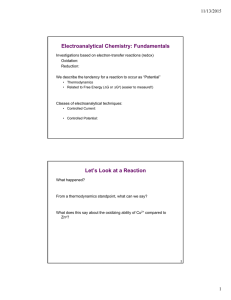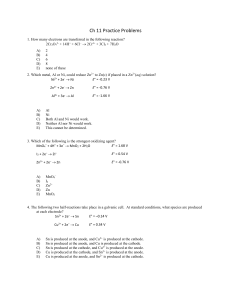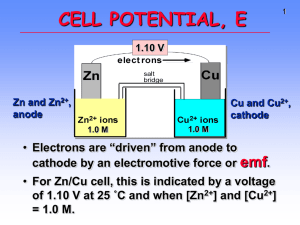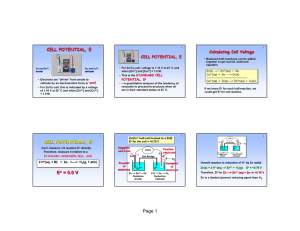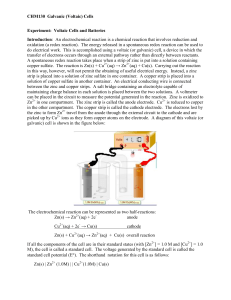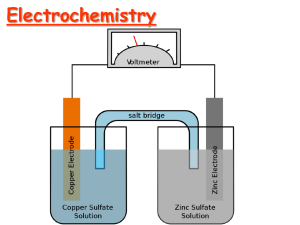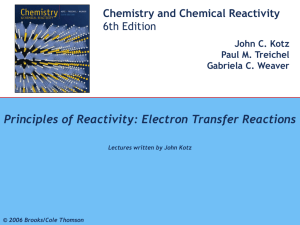Electrochem
advertisement
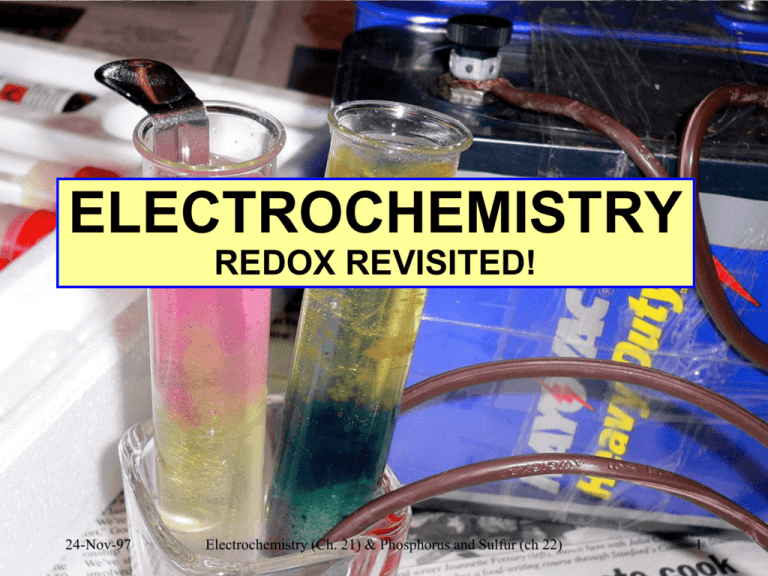
ELECTROCHEMISTRY REDOX REVISITED! 24-Nov-97 Electrochemistry (Ch. 21) & Phosphorus and Sulfur (ch 22) 1 24-Nov-97 Electrochemistry (Ch. 21) & Phosphorus and Sulfur (ch 22) 2 ELECTROCHEMISTRY • redox reactions • electrochemical cells • electrode processes • construction • notation Electric automobile • cell potential and Go • standard reduction potentials (Eo) • non-equilibrium conditions (Q) • batteries • corrosion 3 CHEMICAL CHANGE ELECTRIC CURRENT Zn metal Cu2+ ions With time, Cu plates out onto Zn metal strip, and Zn strip “disappears.” • Zn is oxidized and is the reducing agent Zn(s) Zn2+(aq) + 2e• Cu2+ is reduced and is the oxidizing agent Cu2+(aq) + 2e- Cu(s) http://www.youtube.com/wat 4 wire ANODE CATHODE elect rons OXIDATION Zn Zn2+ ions salt bridge REDUCTION Cu Cu2+ ions • Electrons travel thru external wire. • Salt bridge allows anions and cations to move between electrode compartments. • This maintains electrical neutrality. 5 CELL POTENTIAL, Eo For Zn/Cu, voltage is 1.10 V at 25°C and when [Zn2+] and [Cu2+] = 1.0 M. • This is the STANDARD CELL POTENTIAL, Eo • Eo is a quantitative measure of the tendency of reactants to proceed to products when all are in their standard states at 25 °C. 6 o E and o G Eo is related to Go, the free energy change for the reaction. Go = - n F Eo • F = Faraday constant = 9.6485 x 104 J/V•mol •n = the number of moles of electrons transferred. Zn / Zn2+ // Cu2+ / Cu n for Zn/Cu cell ? n=2 Michael Faraday 1791-1867 Discoverer of • electrolysis • magnetic props. of matter • electromagnetic induction • benzene and other organic chemicals 7 Eo and Go (2) Go = - n F Eo • For a product-favored reaction – battery or voltaic cell: Chemistry electric current Reactants Products Go < 0 and so Eo > 0 (Eo is positive) • For a reactant-favored reaction - electrolysis cell: Electric current chemistry Reactants Products Go > 0 and so Eo < 0 (Eo is negative) 8 STANDARD CELL POTENTIALS, Eo • Can’t measure half- reaction Eo directly. Therefore, measure it relative to a standard HALF CELL: the Standard Hydrogen Electrode (SHE). 2 H+(aq, 1 M) + 2eEo = 0.0 V H2(g, 1 atm) 9 STANDARD REDUCTION POTENTIALS Oxidizing ability of ion Half-Reaction Eo (Volts) Cu2+ + 2e- Cu + 0.34 2 H+ + 2e- H2 0.00 Zn2+ + 2e- Zn -0.76 BEST Oxidizing agent Cu ? ?2+ BEST Reducing agent ?Zn ? Reducing ability of element 10 Using Standard Potentials, Eo • See Table 21.1, App. J for Eo (red.) • Which is the best oxidizing agent: O2, H2O2, or Cl2 ? • Which is the best reducing agent: Sn, Hg, or Al ? H2O2 /H2O +1.77 Cl2 /Cl- +1.36 O2 /H2O +1.23 Hg2+ /Hg +0.86 Sn2+ /Sn -0.14 Al3+ /Al -1.66 • In which direction does the following reaction go? Cu(s) + 2 Ag+(aq) Cu2+(aq) + 2 Ag(s) As written: Eo = (-0.34) + 0.80 = +0.43 V Ag+ /Ag +0.80 reverse rxn: Eo = +0.34 + (-0.80) = -0.43 V Cu2+ / Cu +0.34 11 Cells at Non-standard Conditions For ANY REDOX reaction, • Standard Reduction Potentials allow prediction of direction of spontaneous reaction If Eo > 0 reaction proceeds to RIGHT (products) If Eo < 0 reaction proceeds to LEFT (reactants) • Eo only applies to [ ] = 1 M for all aqueous species • at other concentrations, the cell potential differs • Ecell can be predicted by Nernst equation 12 Cells at Non-standard Conditions (2) Eo only applies to [ ] = 1 M for all aqueous species at other concentrations, the cell potential differs Ecell can be predicted by Nernst equation E = Eo - RT ln (Q) nF n = # e- transferred F = Faraday’s constant = 9.6485 x 104 J/V•mol Q is the REACTION QUOTIENT (recall ch. 16, 20) Go, Eo refer to ALL REACTANTS relative to At equilibrium G = 0 E= 0 Q=K ALL PRODUCTS 13 Example of Nernst Equation E = Eo - RT ln (Q) nF Q. Determine the potential of a Daniels cell with [Zn2+] = 0.5 M and [Cu2+] = 2.0 M; Eo = 1.10 V A. Zn / Zn2+ (0.5 M) // Cu2+ (2.0 M) / Cu Zn(s) + Cu2+(aq) Zn2+(aq) + Cu(s) [Zn2+] Q=? [Cu2+] E = 1.10 - (0.0257) ln ( [Zn2+]/[Cu2+] ) 2 E = 1.10 - (-0.018) = 1.118 V 14 Nernst Equation (2) E = Eo - RT ln (Q) nF Q. What is the cell potential and the [Zn2+] , [Cu2+] when the cell is completely discharged? A. When cell is fully discharged: • chemical reaction is at equilibrium •E=0 G = 0 •Q=K and thus 0 = Eo - (RT/nF) ln (K) Determine Kc from Eo by Kc = e (nFEo/RT) or Eo = (RT/nF) ln (K) or ln (K) = nFEo/RT = (n/0.0257) Eo at T = 298 K So . . . K = e (2)(1.10)/(.0257) = 1.5 x 1037 15 Primary (storage) Batteries Anode (-) Zn Zn2+ + 2e- Cathode (+) 2 NH4 + 2e- 2 NH3 + H2 + Common dry cell (LeClanché Cell) Anode (-) Zn (s) + 2 OH- (aq) ZnO (s) + 2H2O + 2e- Cathode (+) Mercury Battery (calculators etc) HgO (s) + H2O + 2e Hg (l) + 2 OH- (aq) 16 Secondary (rechargeable) Batteries Nickel-Cadmium 11_NiCd.mov 21m08an5.mov Anode (-) Cd + 2 OH- Cd(OH)2 + 2eDISCHARGE Cathode (+) NiO(OH) + H2O + e- Ni(OH)2 + OHRE-CHARGE 17 Secondary (rechargeable) Batteries (2) Lead Storage Battery 11_Pbacid.mov 21mo8an4.mov • Con-proportionation Anode (-) Eo = +0.36 V + + 2ePb(s) + HSO4- PbSO (s) + H 4 Cathode (+) Eo = +1.68 V reaction - same species produced at anode and cathode • RECHARGEABLE PbO2(s) + HSO4- + 3 H+ + 2e- PbSO4(s) + 2 H2O Overall battery voltage = 6 x (0.36 + 1.68) = 12.24 V 18 Corrosion - an electrochemical reaction Electrochemical or redox reactions are tremendously damaging to modern society e.g. - rusting of cars, etc: EOX = +0.44 anode: Fe - Fe2+ + 2 eERED = +0.40 cathode: O2 + 2 H2O + 4 e- 4 OHnet: 2 Fe(s) + O2 (g) + 2 H2O (l) 2 Fe(OH)2 (s) Ecell = +0.84 Mechanisms for minimizing corrosion • sacrificial anodes (cathodic protection) (e.g. Mg) • coatings - e.g. galvanized steel •- Zn layer forms (Zn(OH)2.xZnCO3) • this is INERT (like Al2O3); if breaks, Zn is sacrificial 19 Electrolysis of Aqueous NaOH Electric Energy Chemical Change Anode : Eo = -0.40 V 4 OH- O2(g) + 2 H2O + 2e- Cathode : Eo = -0.83 V 11_electrolysis.mov 21m10vd1.mov 4 H2O + 4e- 2 H2 + 4 OH- Eo for cell = -1.23 V since Eo < 0 , Go > 0 - not spontaneous ! - ONLY occurs if Eexternal > 1.23 V is applied 20 • Go to Molecular Workbench and find the “other activites”. Select from the top list “How a battery works” and do all sections. • You will not regret it! • electrochemical cell animation : http://www.youtube.com/watch?v=A0VUsoeT 9aM 24-Nov-97 Electrochemistry (Ch. 21) & Phosphorus and Sulfur (ch 22) 21


